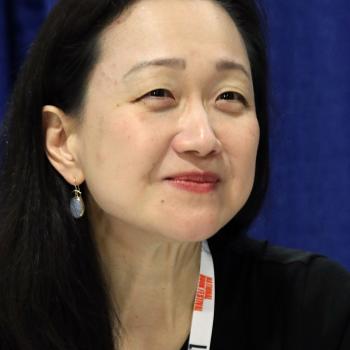Most historians publish their dissertations as a book, then aim for a second project that might tackle a larger topic or reach a broader audience.
Matthew Bowman has worked in reverse. Earlier this year, Random House published his The Mormon People: The Making of an American Faith. The paperback will be out on the weekend of the GOP Convention.
I consider Matt a kindred spirit of sorts. I’m a Protestant who has written on my own tradition and then ventured into Mormonism. He’s a member of the Church of Jesus Christ of Latter-day Saints who has published on his own tradition but has spent most of his time studying American Protestantism. His dissertation, which I’ve read, is a brilliant reconstruction of the world of New York City Protestantism in the late 1800s and early 1900s.
Q: Your dissertation in a few sentences?
MB: It’s a work of history, to be sure, but I think I’m influenced as much by anthropology of religion – the work of people like Brian Malley and Nancy Ammerman and Susan Harding – as I am by historians. What I’m really interested in is getting inside the heads of these Protestants, taking seriously words like “conversion” and “Holy Spirit,” and then building outward from there. Protestant evangelicals believed that the power of Christ could order their city – from the intimacies of human relationships to the chaotic ebb and flow of traffic on their streets. In fact, they believed the Great Awakenings had done so, through the regularizing power of the Word of God expressed through speech and scripture. The unholy trifecta of the late nineteenth century, immigration, industrialization, and urbanization disrupted this order in quite literal ways. Crowds of immigrants broke the small, tightly knit neighborhoods of evangelical congregations; industrial capitalism and eventually consumerism flooded the streets with alternative noise and language and print media, drowning out the minister and burying the Bible; the transformation of downtown Manhattan strangled the old venerable churches of the city. Margaret Lamberts Bendroth points out, wonderfully, that historians often invoke the problems of the city without describing precisely what they are. I try to do that, and then I show how it was in fact evangelical Protestants’ attempt to come to grips with these challenges, to find new ways of channeling the Word of God, that drove the rise not only of Protestant fundamentalism, but of evangelical liberalism as well.
Q: Why study Protestants in NYC, and why this time period?
MB: Fundamentalism gets all the attention at the turn of the twentieth century, which is odd, because by the end of my manuscript – around 1930, with the establishment of the Riverside Church – the people who seem most confident, and even triumphant, are those who called themselves “liberal evangelicals”: Harry Emerson Fosdick, Henry Sloane Coffin, and a few older figures like Henry van Dyke and Charles Parkhurst. These people, I think, get far too little credit, and a great deal of my manuscript is an attempt to rehabilitate them. “Liberal evangelicalism” is an interesting thing; far too often, historians, journalists – pretty much everybody – use the word “evangelical” to mean twentieth century fundamentalists and their mid-century neo-evangelical children; theological conservatives. But Coffin, for one, was quite clear that he believed himself part of the great evangelical tradition: he believed in the unique supernatural significance of Jesus Christ; he believed in conversion experiences; he believed in atonement. Fosdick’s a bit more theologically liberal but when he is ejected from the pulpit of the First Presbyterian Church of New York for, essentially, being theologically liberal he devotes a lot of ink to defending his claim to the term “evangelical.” I picked this time period precisely because I wanted to complicate what that term means today.
Q: Who is your favorite Protestant in your dissertation / book-to-be?
MB: Oh, easily John Roach Straton. His was the first chapter I wrote, and it was eighty pages long before I could stop myself. It’s cliché to describe fundamentalists as evangelicals annoyed about something, and Straton surely was, but just as important, I think, is how calculating he was. He would climb into the pulpit at Calvary Baptist Church in the 1920s and denounce the theatre and the radio and popular entertainment in graphic and lurid terms. It’s easy to see him as an outraged and pinched moralist, but Straton knew precisely what he was doing. Calling him simply angry is missing the point: Straton believed in the power of language, and he chose the words he did because he wanted to evoke exactly the response he did. Later, of course, he gets involved in Pentecostalism and starts picking fights with other fundamentalists in the city, which is even more wonderful.
Q: Least favorite?
MB: Oh, it’s hard. But Charles Briggs was entirely as self-righteous and grumpy as everybody says.Q: Which is more comfortable for you? Studying your own faith tradition, or traditions besides your own?
MB: I think the two, ultimately, seem the same task in my head: understanding how human beings more generally try to make sense of their cosmos. My work in evangelical history and theology has helped me understand Mormons better; I hope that my Mormon background has, in an odd way, helped me deal with the evangelical tradition in a unique way, simply because I don’t have a dog in the fight.












